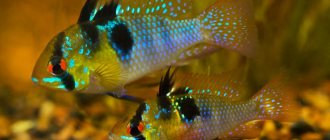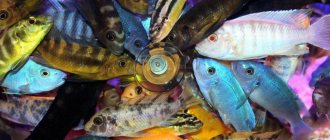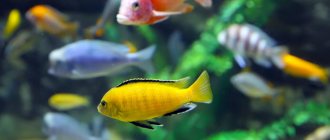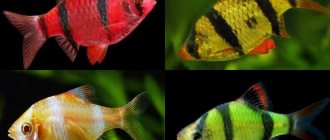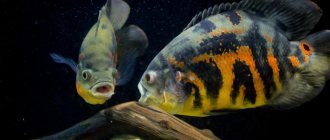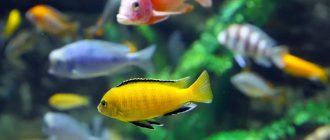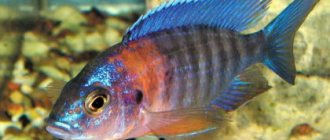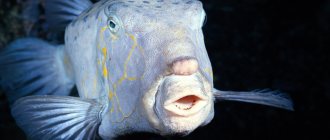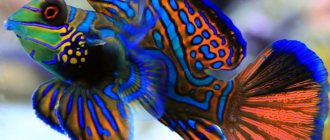The cichlid family consists of many diverse species, representatives of which can be found on almost every continent. To date, science has studied more than 2000 species of fish of this family, but almost half of them are endemic and are found in nature only in two African lakes - Tanganyika and Nyasa. Many species of cichlids have been successfully domesticated, and decorative breeds have been developed from them. What are aquarium cichlids, and what are the features of breeding these beautiful, extraordinary pets?
General description of cichlids
Cichlids are representatives of the order Perciformes, and individuals are found in a wide variety of colors and shapes. The size of the fish can vary significantly - from 2-centimeter shell cichlids to Umbie, which grow up to half a meter in captivity. Some wild individuals reach a meter in length.
In their natural environment, cichlids inhabit fresh and brackish waters of Asia, Africa, and Latin America. Unfortunately, some species have become extinct, while others are on the verge of extinction.
In an aquarium, with good care, fish live 8-10 years. On sale you can find individuals with incredible, unnatural colors - such pigments are the result of artificial procedures, as a result of which the life expectancy of such fish is much shorter.
Habitat
Cichlids are widespread in Southwest Asia, Africa, Central and South America in the Amazon River basin. These fish also live in Madagascar, Sri Lanka and southern India. Many species are endemic to the African Great Lakes.
Cichlids inhabit slow-flowing and stagnant bodies of water with stable water levels and high oxygen concentrations. Representatives of certain species live in the brackish waters of river mouths and even spend part of their time at sea.
Peculiarities of behavior of cichlids
Owners are captivated by the ability of some cichlids, mostly peaceful varieties, to remember their owner and recognize him. The fish can eat from his hand, but they do not show such friendliness and trust towards strangers. Representatives of these breeds are true family men; while still teenagers, they independently form pairs and walk, fin to fin, throughout their lives.
Cichlids are caring parents; they tirelessly watch the eggs, fan them with their fins and do not allow other inhabitants to approach them. Their joint care also extends to the fry. Fish love to rummage in the ground, and large specimens easily uproot vegetation and turn over large cobblestones. This must be taken into account when arranging a home for such inhabitants.
Particularly original specimens
Auratus cichlids
The species Auratus should be mentioned in this section. These fish have a second extravagant name: golden parrot. Females and males of Auratus differ significantly in color, which makes the choice easier at the time of pair formation, since the female of Auratus is even more pugnacious than the male. It is interesting that if there is no male in the house (aquarium), the most active and respected female can change her color and become like a male auratus. Auratus does not have the opposite effect.
The southern Malawian reservoir is the place where the blue dolphin originated - a striking representative of the cichlid, strongly reminiscent of the mammal of the same name. The pad on the male's forehead grows year by year, making the fish more and more like him. The success of their home breeding depends entirely on the health of the parents, which requires:
- bright lighting;
- filtering or changing a third of the water weekly;
- maintaining an alkaline pH.
Pseudotropheus Lombardo
A few words about the uniqueness of the cichlid pseudotropheus (Lombardo). It is important that only experienced aquarists can properly maintain a pawnshop. These are beautiful, aggressive individuals, extremely sensitive to changes in water. Female and male Lombardos are so differently colored that they are sometimes mistaken for different species. Lombardos do not get along even with peaceful cichlids.
Three-hybrid parrot - Cichlasoma flowerhorn
Three-hybrid parrot - Cichlasoma flowerhorn. This is the result of the selection work of ichthyologists. In addition to a highly developed bump on the forehead, it is characterized by:
- frequent radical changes in color;
- tendency to loneliness;
- the presence on the scales of a pattern similar to a heart.
Species diversity
Few families can boast of such an abundance of different breeds. Among the South American cichlids, aquarists are interested in the following fish:
- bluish-spotted acara – 10-15 cm striped fish with a grayish-brown body and golden-greenish scales;
- Nannakar anomaly – angry fish (5-7 cm), which can keep other, even larger inhabitants at bay, but the bronze-green color of the males, against which there are dark spots, is captivating;
- Ramiresi's apistograms – bright, yellow individuals with purple and greenish metallic tints; she is considered the most beautiful dwarf cichlid;
- black-striped cichlasoma – a visitor from the lakes of Guatemala, which is called a zebra because of its vertical black stripes;
- angelfish – one of the most common representatives of the cichlid family, having an unusual body shape in the form of a flat triangular crescent;
- discus - fastidious and incredibly beautiful, for which they were called the kings of the aquarium world. These fish have a flat, round disc-like body and luxurious colors - both natural and resulting from selection;
- astronotuses – even in captivity, the fish grow up to 20-25 cm, which allows them to be called large inhabitants of the aquarium, and have a bright appearance – their body is decorated with yellow or orange stripes and spots.
Many African cichlids have also successfully adapted in captivity and are loved by aquarists:
- handsome chromis - a selfish, territorial and aggressive inhabitant, but at the same time possessing charisma and incredible beauty - his bright red body is covered with blue-greenish dots that glow;
- pelmatochromis pulcher – like all cichlids, it has a stern disposition. Representatives of the breed are also called crebentis or parrots. There are several varieties, and some of them have very original colors;
- labidochromis yellow – an endemic fish from Lake Malawi, with a bright yellow color with a contrasting black edging;
- haplochromis venustus - another breed from Malawi, representatives of which in captivity reach 25 cm; males can be distinguished due to luxurious blue markings on the cheeks and fins;
- melanochromis auratus - is one of the most prominent representatives of Malawian pugnacious cichlids. Individuals have pronounced sexual dimorphism - the body of the male is painted black, and it is crossed by a white stripe, while in females the stripe is black, located on a light-colored body.
This is only a small part of the cichlids that managed to charm breeders and attract the attention of aquarium owners. In total there are more than 1200 varieties.
African cichlids
There are river and lake varieties. River fish love soft and acidic water. Famous representatives:
- Nanochromis - has a gray-green body with transverse stripes. Females have a reddish belly
- Pelvicachromis pulcher, a parrot cichlid, is a small fish with a combination of dark brown, light ocher and black stripes running from the tail to the snout. The abdomen of males is reddish
- Lionhead cichlid, Steatocranus - has a gray body with pale yellow spots and a characteristic fatty growth on the forehead
Features of keeping cichlids
Despite the species diversity, most cichlids need similar conditions of detention - nevertheless, in nature they choose reservoirs with similar water parameters, and half of them live in the same lakes. Fish will feel comfortable in the following cases:
- if they are provided with a spacious tank - for large cichlids its volume should be at least 200 liters;
- it is necessary to maintain the temperature regime (27°-28°C) - the fish have a hard time with changes in indicators;
- additional enrichment of water with oxygen and maintenance of cleanliness is required - aeration and filtration are mandatory;
- water is changed weekly - approximately a quarter of the total volume;
- each breed representative must have its own secluded corner - the tank must be zoned using vegetation and decor - pebbles, caves, houses, shards, etc.;
- lighting should be moderate, diffused; the aquarium should not be installed where direct sunlight can penetrate into it.
On sale you can find a special tank - a cichlidarium, which fully meets the requirements of these inhabitants and is equipped with suitable devices. If you have no experience in breeding cichlids, you can always get advice from a specialist.
Diseases
They are susceptible to infections as well as other diseases that affect freshwater fish, especially if the water is stale, poor in quality and oxygenated.
One common problem is white spot disease, which appears as white crusts all over the body. To solve the problem, keep the water temperature in the aquarium at 30℃ for 3 days.
Fish can also get the so-called “hole in the head” disease. It is associated with poor water conditions and unbalanced nutrition.
Feeding cichlids
It all depends on the type of fish, but most cichlids are not particularly picky and eat what is offered to them. You can give the fish frozen, dry diets, or prepare a special mixture in the form of minced meat.
Not all cichlids are predators; some of them are herbivores and require plant food. It is important to take this feature into account when selecting a suitable menu, otherwise they will noticeably spoil the living aquarium decor. The main feature of feeding such fish is that they require balanced, varied food.
What to feed in the aquarium?
Depending on the food supply of fish, cichlids are divided into:
- vegetarians (herbivores);
- carnivores (animal eaters);
- omnivores (fish that readily eat both plant and animal food).
The best food for cichlids will be food that is familiar to a particular species in the natural environment, but in our conditions it is difficult to provide them with flora and fauna from African lakes or American rivers. Therefore, you can feed the fish:
- natural food (live or frozen crustaceans Artemia, Cyclops, Diaptomus, Daphnia, bloodworms, coretra);
- dry food (Tetra, JBL, Tropical, Sera, Wardley, Aquamenu);
- dry algae (spirulina);
- feed mixtures , sea fish (hake, cod, pink salmon);
- minced meat or pieces of seafood (squid, shrimp, mussels);
- scalded green mass of plants (lettuce, dandelions, nettles, cabbage);
- canned vegetables (green peas, corn);
- fresh vegetables (cucumber, carrots, zucchini, pumpkin, spinach, bell pepper).
Carrot
Cichlid breeding
In most cases, male cichlids have larger dimensions and bright colors, which intensify during the spawning period. An important nuance is that in order to get offspring, it is necessary to seed pairs that have formed naturally. If you place fish in a spawning tank that are not partners, they will not reproduce.
If you remove fish that are not ready to reproduce, or individuals between whom there is enmity, they can fight, even to the point of death. For future parents, it is necessary to prepare a separate spacious tank - a spawning tank, in which the temperature regime will be maintained. It also needs to be properly decorated, which will provide suitable conditions for fish breeding.
Cichlids lay eggs on pebbles and other objects with flat surfaces. Representatives of some varieties have the peculiarity of laying and incubating eggs in the oral cavity. The fish are caring parents and care for the eggs, and later the fry, together. They vigilantly monitor the safety of their offspring and zealously drive away strangers.
Aquarium owners have only one thing left to do - provide the juveniles with suitable food - crustaceans, small plankton or special ready-made diets. The fry are given food 5-6 times a day in small portions.
Reproduction
In many cichlids, the females are different from the males. In some species, of course, the differences are not visible at all. They most often differ in color and size.
For the most part, these fish reproduce quite easily. First, a couple is formed, which is very interesting to watch. Cichlids choose a “nest” (a hole in stones, a corner with thickets of grass, a pitcher - depends on the species), protect it from neighbors, and the male cares for the female.
All cichlids are egg-laying. The female lays eggs and the male fertilizes them. But during evolution, two main types of bearing offspring have emerged. The first is traditional, when parents take turns guarding the eggs, fanning them with their fins. The second is primarily characteristic of the cichlids of Malawi and Tanganyika, where there are many enemies and few shelters. The parents hatch the eggs in their mouths. When the offspring hatch, the cichlid fry still hide in their parents’ mouths for some time at the slightest danger.
Tendency to diseases
Aquarium cichlids have endurance and good health, but if not kept correctly, they can get sick. Diseases are often caused by poor quality or inappropriate nutrition. Most often, cichlids get fish lice; if the fish begins to often scratch itself on the stones, its fins have shrunk, and its body is covered with a white coating, then most likely we are talking about ichthyophthyriosis, which is caused by these parasites.
The second most common fish disease is saprolegniosis - it manifests itself as a fungal infection that resembles a piece of cotton wool. Affected individuals are placed in a separate tank and undergo appropriate therapy. Then they have to sit in a quarantine aquarium so as not to infect healthy fish.
Health problems
Cichlids are relatively strong fish with good immunity. But poor quality nutrition, underfeeding, stress, nitrates and inappropriate water levels can lead to the development of health problems.
Most often, aquarium cichlids are diagnosed with diseases such as:
- Hexamitosis. Accompanied by enlarged pores in the lateral line and head, complete lack of appetite and exhaustion. The disease is treated with metronidazole and, in the absence of timely assistance, leads to the death of pets.
- Ichthyophthyriosis. A striking symptom of the disease is the appearance of a white coating, reminiscent of semolina. It is treated only with specialized drugs, among which is quinine hydrochloride.
- Saprolegniosis. The disease is accompanied by the appearance of growths resembling cotton wool and is treated with drugs based on phenoxyethanol.
- American bloat. Sick fish become lethargic and lose interest in food. Their eyes bulge and their bodies swell. The disease is most often diagnosed in natives of Lake Malawi and develops over three days. If during this time the fish is not treated with antibiotics, it will die.
Aquarium cichlids are exotic fish that share a number of common characteristics. They need a spacious aquarium filled with clean, warm water and do not get along well with small neighbors.
Compatibility of cichlids with other inhabitants
Regardless of size, all members of the family are quite capricious and territorial; they actively protect their territory from foreign invasion, especially during spawning. Even with close relatives, fish most often do not have warm relationships. It is important to divide the tank into zones and place fish that live in other layers of water with cichlids.
Small, modest and calm fish will have a hard time in the company of cichlids - they will be offended or even eaten. In any case, when considering the possibility of keeping cichlids in a common tank, you should definitely take into account the character traits of representatives of a particular species. In addition, it is important to consider who may live under the same water parameters, as well as the size of possible neighbors.
Aquarium cichlids are a real decoration for any aquarium. But not all of them are simple in content. The owner needs to evaluate his own knowledge and experience when selecting suitable pets.
